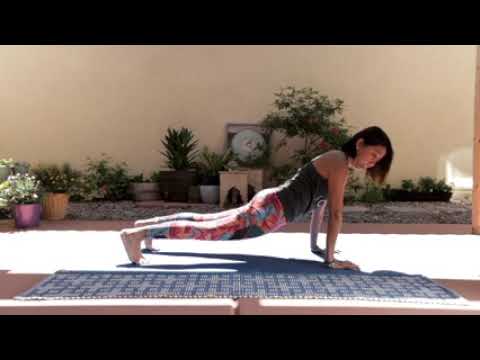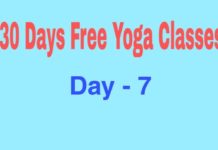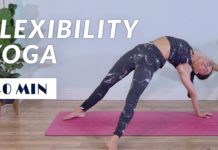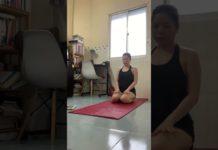Core Strange Work Out for Women: The Yoga Journey Day 4 Core Power Yoga
Video
Description
Plank Phalakasana
Plank is the foundation of building the strength in your shoulders, arms, chest, and core. In fact, this pose is the fastest way to develop strength and is also often used in transitioning from pose to pose during a yoga sequence. For those of you women who believe that you don’t have a strong core, let us focus on this pose. Keep practicing every day.
When I first started yoga, I already had a lot of flexibility because I was a dancer. However, I did not have a lot of strength. I hate to do push ups or any poses for core work. When I started learning the correct way to do the plank, I began to see the difference in my body. My core, my shoulder, and arms feel stronger, and now it’s become my favorite pose.
Place your hands and knees on the mat, tuck your toes under, and align your wrists with your shoulders.
Lift your knees up away from your mat and keep your legs straight. Press your hands firmly on the mat and keep your body lifted. Breathing deeply and calmly, hold this position for about 3-5 breaths.
Variations:
If you feel that this plank is too much for your wrists, you can start with standing on your mat and using the wall to support your body weight. This pose is about strength and stability. So, use the wall and the variations to help give your body more support.
Stand facing the wall, the distance between you and the wall is about the length of your arms. Place the blocks between your thighs and start to engage your core.
Hold your arms at your shoulder level, place both hands flat on the wall, and start to press your hands against the wall. Slowly lean your body weight into the wall. Keep engaging your core and your thighs, feeling like you are pushing yourself away from the wall. Practice and hold this pose for 3-5 breaths.
You can still do the plank on the mat facing away from the wall, and place your heels against the wall. Feel free to put both knees down on the mat whenever you need to.
Chaturanga Dandasana (Low Plank)
If you feel that you are ready to give yourself a little bit more of a challenge, let’s practice this low plank to help your body increase more strength. Remember to try your best to do it correctly and follow this instruction.
Start with placing your hands and knees on your mat, your hands underneath your elbows and shoulders, knees underneath your hips.
Tuck your toes under, and lift your knees and your body. Extend your legs straight, keeping your toes curled, pressing your hands firmly on your mat. Curl your heels away from your body, chest forward. Lift the back of your thighs, engaging your core.
Inhale, take a deep breath, exhale, bend your elbows, and lower your chest down until your upper arms align with your torso. Bring your elbows close to the side of your body; you might see both elbows stay in 90-degree angles there. Engage your core, squeeze your thighs together. Pull your shoulder blades together and down. Keep breathing deep and slow holding disposition about 1-3 breaths.
To make this pose accessible and to still build strength, you can place the bolster under your torso then lower your body onto the bolster, or you can place a yoga block on the mat under your torso then lower your torso onto the block. Another variation, keep one or both knees on the mat to support your weight. Remember to keep your back straight; arching your back will cause the lower back pain, so engage your core and try to lengthen your spine.













